Good Friday, Holy Friday, Great Friday, Great and Holy Friday, or Black Friday, Illustrated with Scriptures and Commentary
By James Tissot and Dom Guéranger
Note: This series was originally posted at Dappled Things Deep Down Things blog and has been edited. Today’s post includes new illustrations and added commentary from James Tissot.
Selected illustrations for Good Friday:
+ Peter's First Denial of Jesus
+ Peter's Second Denial of Jesus
+ The Third Denial of Peter. Jesus' Look of Reproach
+ The Cock Crowed
+ The Sorrow of St. Peter
+ Christ is Mocked in the House of Caiaphas
+ Jesus Meets His Mother
+ The Holy Face
+ The Raising of the Cross
+ What Our Lord Saw from the Cross
+ The Dead Appear in the Temple
+ Jesus in the Sepulchre
The titles of Tissot's many other images for the events of Good Friday not shown on this page are linked to where the images may be viewed at another site with accompanying Bible verses.
These illustrations and commentary are from Volumes III and IV in The Life of our Saviour Jesus Christ: three hundred and sixty-five compositions from the four Gospels. You can see the main illustrations (and supplemental illustrations) and read all of Tissot’s extensive commentary for free at the Internet archive. The meditations in Tissot’s commentary are heart-wrenching, taken from the Scriptures and the visions of Blessed Anne Catherine Emmerich of Christ’s life. The “First Denial” starts here in Volume III.
Peter's First Denial of Jesus
John 18:15-17: "Simon Peter and another disciple were following Jesus. Because this disciple was known to the high priest, he went with Jesus into the high priest's courtyard, but Peter had to wait outside at the door.
"The other disciple, who was known to the high priest, came back, spoke to the girl on duty there and brought Peter in.
"'You are not one of his disciples, are you?' the girl at the door asked Peter.
"He replied, 'I am not.'"
Peter's Second Denial of Jesus
John 18:18, 25: "It was cold, and the servants and officials stood around a fire they had made to keep warm. Peter also was standing with them, warming himself....
"As Simon Peter stood warming himself, he was asked, 'You are not one of his disciples, are you?'
"He denied it, saying, 'I am not.'“
The Torn Cloak: Jesus Condemned to Death by the Jews
Tissot’s commentary: “In spite of his repeated denials, Peter approached the Judgment Hall to try to see what was going on, whilst Saint John thus left to himself had availed himself of his own special facilities to secure a place as near as possible to Jesus. Peter, finding himself surrounded on all sides by strangers, for as a Galilean he was, of course, a foreigner, and attracted the constant notice of the guards by his peculiar accent, became nervous, lost his presence of mind and, getting more and more over-excited, he denied his Master for the third time. . . . They that stood by said again to Peter, ‘Surely thou art one of them: for thou art a Galilean and thy speech agreeth thereto.’ When the scene represented in my picture took place, the trial was over, the sentence had been pronounced, and the judges were retiring. It is late, about three o'clock, and the cock crows again, Jesus is leaving the Judgment Hall, given over for a few moments to the tumultuous mob, intoxicated with fury against Him. which has been surging about the scene of the trial for nearly four hours. He is being taken, subjected the while to the most cruel treatment, to a small prison adjoining the Judgment Hall where He is to be kept in sight by His guards for the rest of the night, and it is in this short transit that Jesus turns round and looks upon Peter. It would indeed be difficult to analyze all that look expressed; but Peter himself understood it all too well, that rapid glance lights tip his troubled conscience like a flash of lightning in the night, and suddenly everything comes back to his memory: his protestations on the way to Gethsemane, the warnings of Jesus, his own thrice-repeated denial and the crowing of the cock.”
The Third Denial of Peter. Jesus' Look of Reproach
Luke 22:59-61: "And about the space of one hour after another confidently affirmed, saying, ‘Of a truth this fellow also was with him: for he is a Galilaean.’
“And Peter said, ‘Man, I know not what thou sayest.’ And immediately, while he yet spake, the cock crew.
“And the Lord turned, and looked upon Peter. And Peter remembered the word of the Lord, how he had said unto him, ‘Before the cock crow, thou shalt deny me thrice.’”
The Cock Crowed
The Sorrow of St. Peter
Luke 22:61: "And he went outside and wept bitterly."
Christ is Mocked in the House of Caiaphas
Luke 22:63-65. “And the men that held Jesus mocked him, and smote him.
“And when they had blindfolded him, they struck him on the face, and asked him, saying, ‘Prophesy, who is it that smote thee?’
“And many other things blasphemously spake they against him.”
Tissot’s Commentary: “The subject now represented takes us back to a little before the third denial of Peter, or at least to before the Lord turned and looked at him, for we assume that the look was given on the way to prison, Jesus once condemned by acclamation on the suggestion of the High Priest himself, a nameless scene of horror began. The Sanhedrim, instead of protecting Him from the crowd, as in such a case it was the duty of the legal authorities to do, abandoned Him to their mercy and thus sanctioned the worst outrages. It is true that the members of the Supreme Council did not themselves take any part in the insults heaped on Jesus, but there is not the slightest doubt that they were as responsible as if they had, for they certainly could have prevented them. His persecutors flung themselves upon the Prisoner with a positively diabolical fury, raining blows upon Him, ‘spitting in His face, buffeting Him and smiting Him with the palms of their hands.’ They blindfolded Him with a dirty rag, and as they struck Him they mocked Him, saying: ‘Prophesy unto us, thou Christ, who is he that smote thee?’ Truly the unfortunate Victim paid dearly enough now for His brief triumph on Palm Sunday, for the homage paid to Him at Bethany, for the precious ointment of Mary Magdalene and for His few short moments of joy, which He must now expiate with all this agony and humiliation. The enemies of the Prophet cannot but have been intoxicated with the thought of having Him, Who had previously caused them so much anxiety, in their hands under such conditions. But the night was far spent, even the tormentors were getting weary, and there was no longer any danger of the escape of their Victim. The crowd now melted away and the guards led Jesus, with soiled garments, bleeding face, and limbs bruised by the blows He had received and galled by His fetters, as He had now been bound some four hours, it being already three o'clock in the morning, that is to say, eleven hours since He was taken prisoner. Long before, Job had said, and his words were perhaps prophetic of the sufferings of Christ: ‘They have gaped upon with their mouth, they have smitten me upon the cheek reproachfully; they have gathered themselves together against me.’ These words were literally fulfilled in the scene we have just described, and yet more remarkably true was the beautifully worded prophecy of Isaiah, when he glorified beforehand the divine gentleness of the insulted Messiah, saying: ‘I gave my back to the smiters, and my cheeks to them that plucked off' the hair; I hid not my face from shame and spitting.’
Good Friday Morning: Jesus in Prison
The Morning Judgment
Judas Returns the Blood Money
Judas Hangs Himself
Having Deserted Jesus, the Disciples Hide in the Valley of Hinnom
Jesus Is Led from Caiaphas to Pilate
Jesus Appears before Pilate for the First Interview
Portrait of Pontius Pilate*
Pilate's Wife Warns Him of a Dream
Jesus Before Herod
Jesus Is Led Back from Herod to Pilate
The following illustrations are from Volume IV of The life of our Saviour Jesus Christ : three hundred and sixty-five compositions from the four Gospels.
The Scourging of the Face
The Scourging of the Back
The Scapegoat*
The Crowning of Thorns
Behold the Man. Ecce Homo
Jesus Appears before Pilate for the Second Interview
Barabbas*
Let Him Be Crucified!
Pilate Washes His Hands
The Holy Stairs
Jesus Leaves the Praetorium
Bird's-Eye View of the Forum
The Judgment on the Gabbatha
The Title on the Cross
They Put His Own Clothes on Him
Jesus Bearing the Cross
Jesus Falls Beneath the Cross
Jesus Meets His Mother
Tissot’s Commentary: “The meeting of Jesus with His Mother is not referred to in the Gospel narrative, but tradition is unanimous in asserting that it took place at the fourth Station of the Via Dolorosa. Marv was accompanied by Saint John, Mary Magdalene and Mary Salome, with other Holy Women, who, the Evangelists tell us, followed the Master to Calvary. It was very natural that the Mother of the Lord should have been present in the Forum at the scourging, though at a distance, and should have witnessed from afar the Ecce Homo incident: in fact, that she should have seen all that the rest of the crowd did. When the procession began to move off on its way to Golgotha, Mary, who had just heard the sentence of death passed upon her Son from the Gabbatha and who had seen the cross placed upon His shoulders, tried to get near enough to Him to help Him with His burden, but it was impossible, for the narrow street was already blocked up with soldiers and the crowds accompanying the Victim. The Virgin was, therefore, compelled to take another route and, after a most careful examination of the district, we feel able to assert pretty confidently which way she went. A tradition tells us that in the angle formed by the street leading to the Sheep-Gate and the Tyropœon Valley, or Valley of the Cheese Merchants, there was a house with court-yards and out-buildings belonging to Caiaphas, who, as we know, had his Judgment Hall in the Sion quarter. Now Saint John, as already stated above, had relations amongst the attendants of the High Priest, and it was thanks to this circumstance that he was able to go into the Judgment Hall and to secure the admittance of Saint Peter. He would thus also be able to let the Blessed Virgin and her companions pass through the courts and gardens of this house and, cutting diagonally across from one street to another, he managed for the little party of friends of the Master to arrive at the fourth Station of the Cross in time to meet Jesus, without having to go up the steep ascent climbed by the procession. The locality speaks for itself in a remarkable way, and no one who has considered the matter on the spot, can fail to feel sure that the meeting between the Mother and Son took place on the spot indicated above and nowhere else. It is generally supposed that the fall of Jesus occurred at the very moment of the touching meeting. This is what Anne Catherine Emmerich says on the subject: ‘Then one of the executioners asked of those standing by: “Who is that woman lamenting so bitterly?” And some one replied: “It is the Mother of the Galilean.” Then the wretches loaded the unhappy Mother with insult and mockery, they pointed at her with their fingers, and one of them took the nails which were to fasten Jesus to the Cross and struck Him with them, mocking Him before the eyes of the Blessed Virgin. As for her, she gazed upon Jesus and, overwhelmed with grief, was obliged to lean against the door to save herself from falling. She was as pale as death and her lips were livid.’”
Simon the Cyrenian Compelled to Carry the Cross with Jesus
Simon of Cyrene and his two sons Alexander and Rufus*
A Holy Woman Wipes the Face of Jesus
The Holy Face
The Daughters of Jerusalem
The Procession Nearing Calvary
The Holy Women Watch from Afar
The disciples, having left their hiding place, watch from afar
Jesus is taken from the old cistern*
Jesus Stripped of His Clothing
Wine Mixed with Myrrh or Gall
The First Nail
The Nail Driven into the Feet
The Raising of the Cross
Tissot’s Commentary: “The whole operation is really accomplished in the twinkling of an eye, and, through the darkness and gloom, which are ever on the increase, the body of the Lord, of the bluish-white colour of marble, dashed with the red blood from His wounds is seen to rise up through the air before the spectators who look on in a silence weighted with tragedy. Mary, the mother of the Sufferer, and the friends who have been 'with her from the first are still there, following all that the, beloved Victim goes through voith eyes full of anguish; their hearts are crucified with Him, they feel as if their own last hour had come.”
The Five Wedges of the Cross
Pardon of the Good Thief
They Parted His Raiment and Cast Lots
And Sitting Down They Watched Him There
What Our Saviour Saw from the Cross
Tissot’s Commentary: "This is the idea I wish to express in my engraving: a momentary lull has occurred in the midst of the shouts and insults of the spectators, who are alarmed by the threatening signs in the sky and by the ever-increasing darkness. Now, from the top of the Cross on the summit of Golgotha, which dominates the town of Jerusalem, Jesus looks down on those beneath Him. The eyes of all, those eyes which are the windows of the soul, are fixed on Him; He sees every one who has aided in His condemnation, including the judge himself. Down at His still bleeding feet He sees, as He bends His head, the weeping Magdalene, consumed with the fervour of her love and penitence: whilst beyond her stands His mother, gazing up at Him with an expression of ineffable tenderness; with Saint John, that most devoted of all the disciples, and Mary Salome, the latter weeping bitterly. Farther away are the blasphemers, surfeited at last with the gratification of their malice, but on them, in the very midst of their triumph, has fallen fear and astonishment. In some cases, perhaps, faith in the Redeemer may be already nascent, and stubborn hearts may be touched with the all-powerful grace of God. Yet a little farther off, beyond the wall of the Garden of Joseph of Arimathea, is the sepulchre which that same evening is to receive the body of the Saviour. Beyond the trees, again the dying Sufferer can make out groups of the more timid of His followers, the disciples who, in spite of their love for the Master, dare not approach nearer until the darkness shall be so great that there will be no danger of their being recognized. So profound is the silence that even the distant murmur of voices from the city and the blasts of the trumpets from the Temple can faintly be heard.
"Far away down below rises up a great column of dense smoke from the Altar of Burnt Sacrifice. The wind is in the East and comes from the direction of the Dead Sea, laden with the mixed fumes of incense, burning meat and melting fat; the air is heavy and oppressive, whilst all around is wrapped in a mantle of the deepest gloom.”
Woman, Behold Your Son (Stabat Mater)
The Sorrowful Mother (Mater Dolorosa)
My God, why hast Thou forsaken me?
I thirst. Vinegar given to Jesus
It is finished! (Consummatum est!)
The Death of Jesus
The Crowd Left Beating their Breasts
Earthquake
The Chasm in the Rock in the Cave beneath Calvary*
The Confession of Saint Longinus
The Centurion
The Dead Appear in the Temple
Matthew 27:52-53: "And the graves were opened; and many bodies of the saints which slept arose.”
Tissot’s commentary: “The apparition in the Temple of the departed must have produced a profound impression of dismay upon the consciences of the Jews, for, as is well known, those who came in cont with the dead were rendered impure, and such contact must, according to the Jewish belief, neutralize the efficacy of the Paschal sacrifices. This is why the Lévites are running away alike shocked and terrified.”
The Dead Appear in Jerusalem
The Thieves' Legs Are Broken
The Soul of the Penitent Thief
A Soldier Pierces Jesus in His Side with a Spear
Confession of the Centurion
Jesus Alone on the Cross
Joseph of Arimathea
The Descent from the Cross
The Holy Virgin Receives the Body of Jesus
The body of Jesus is carried to the anointing stone
The Holy Virgin kisses the face of Jesus before it is wrapped in the winding-sheet
Jesus Carried to the Tomb
Jesus in the Sepulchre
John 19:38b-42: "With Pilate’s permission, [Joseph of Arimathea] came and took the body away. He was accompanied by Nicodemus, the man who earlier had visited Jesus at night. Nicodemus brought a mixture of myrrh and aloes, about seventy-five pounds. Taking Jesus’ body, the two of them wrapped it, with the spices, in strips of linen. This was in accordance with Jewish burial customs. At the place where Jesus was crucified, there was a garden, and in the garden a new tomb, in which no one had ever been laid. Because it was the Jewish day of Preparation and since the tomb was nearby, they laid Jesus there."
Reconstruction of Golgotha and the Holy Sepulchre Seen from the Wall of Herod's Palace
Reconstruction of Golgotha and the Holy Sepulchre seen from the Walls of the Judical Gate or Gate of Judgment
Reconstruction of Jerusalem and Herod's Temple
Man of Sorrows
Previous
Overview:
For a more-complete introduction to the amazing unclassifiable works of the complex and unique artist James Tissot, you might want to read this article “Contrasting Visions Of Painter James Tissot, The Secular And Sometime Mystical Realist.”
The images in this series are downloaded from the Brooklyn Museum. "RIGHTS STATEMENT: No known copyright restrictions."
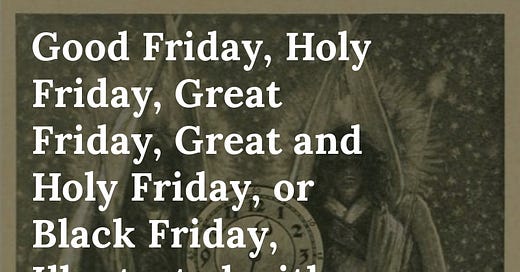




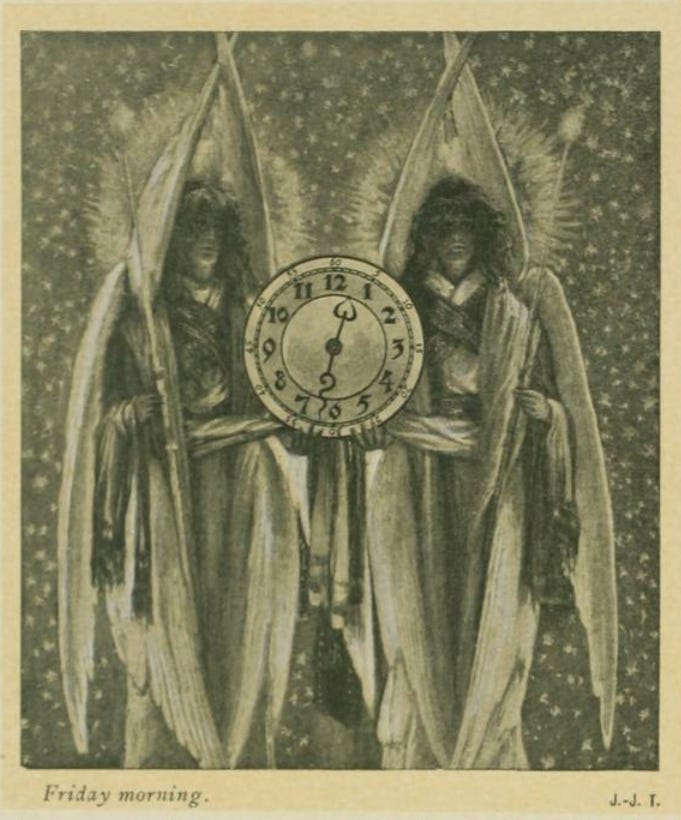

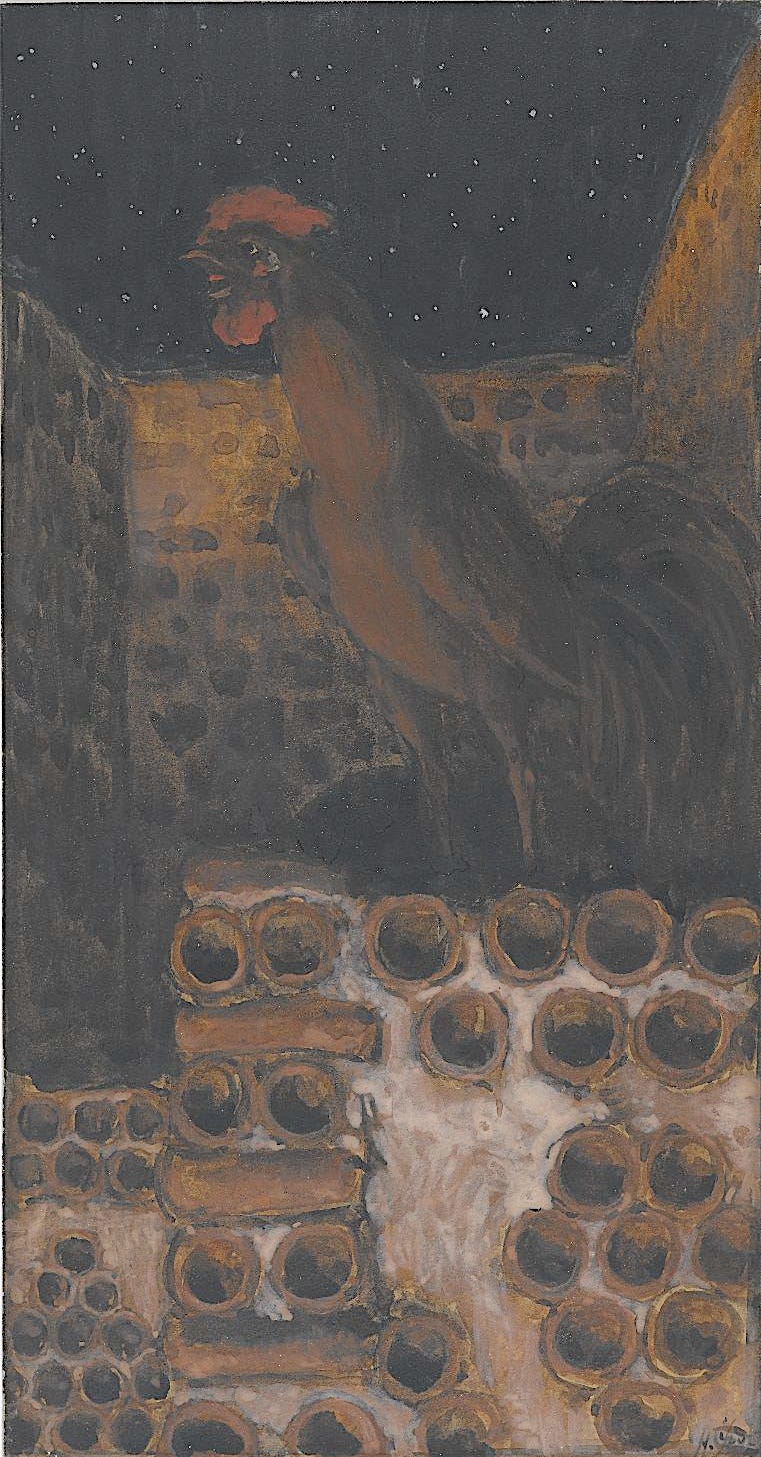

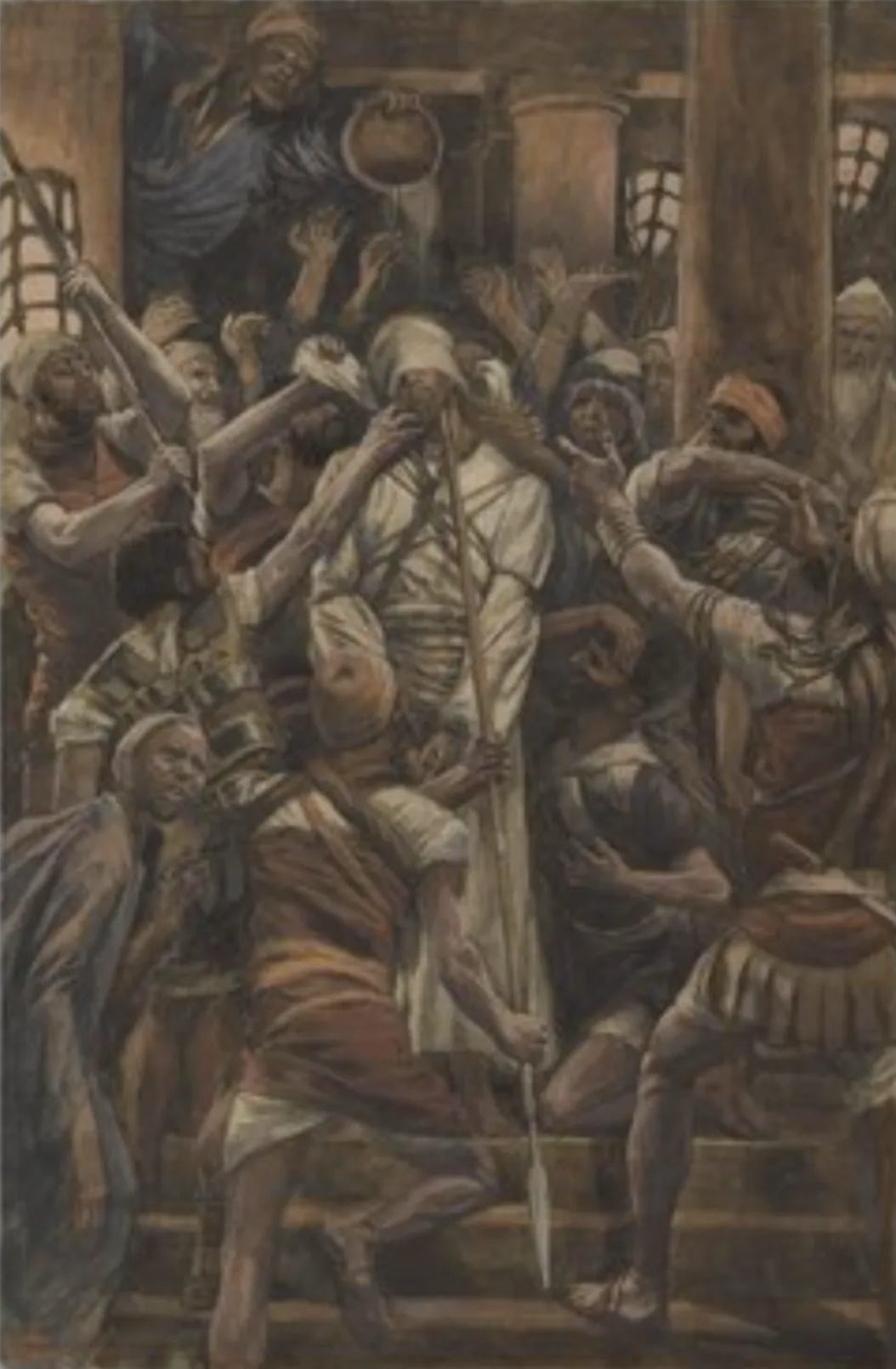

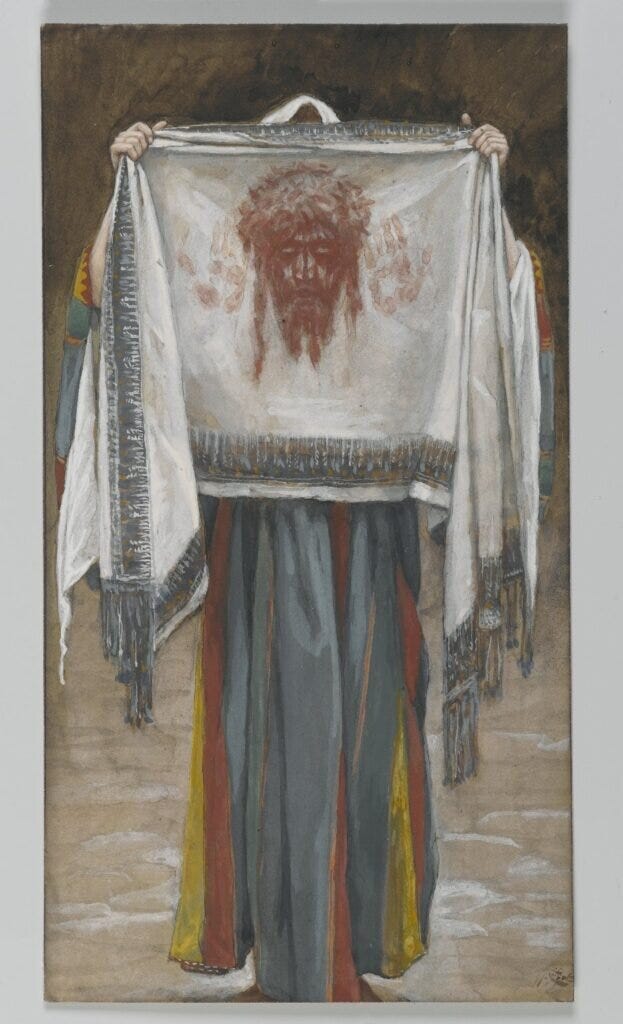
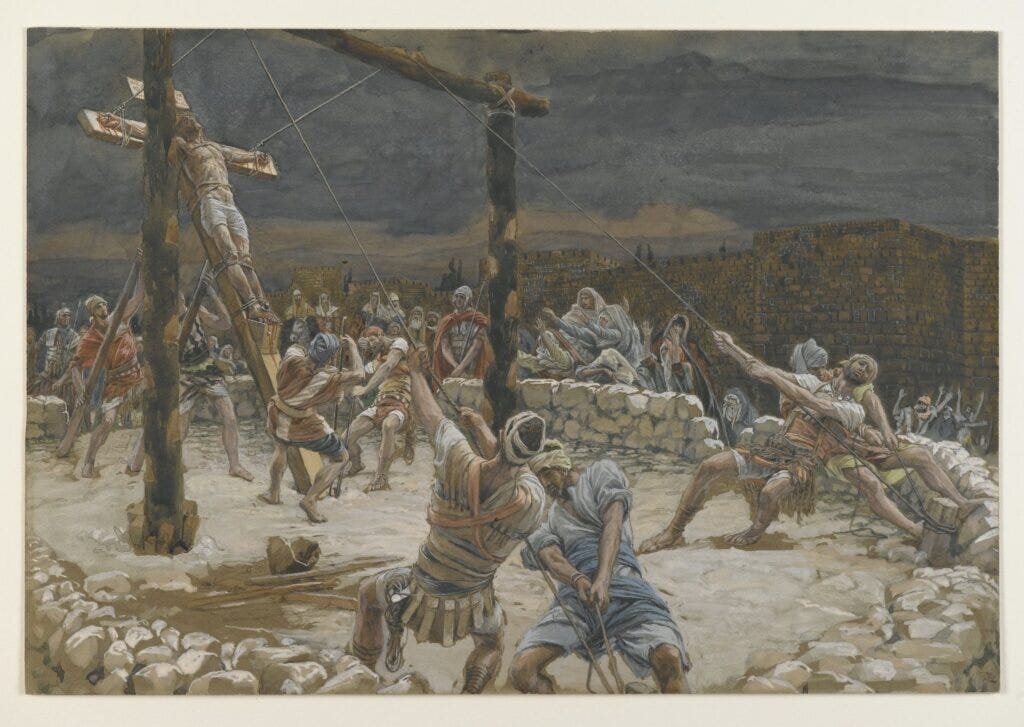
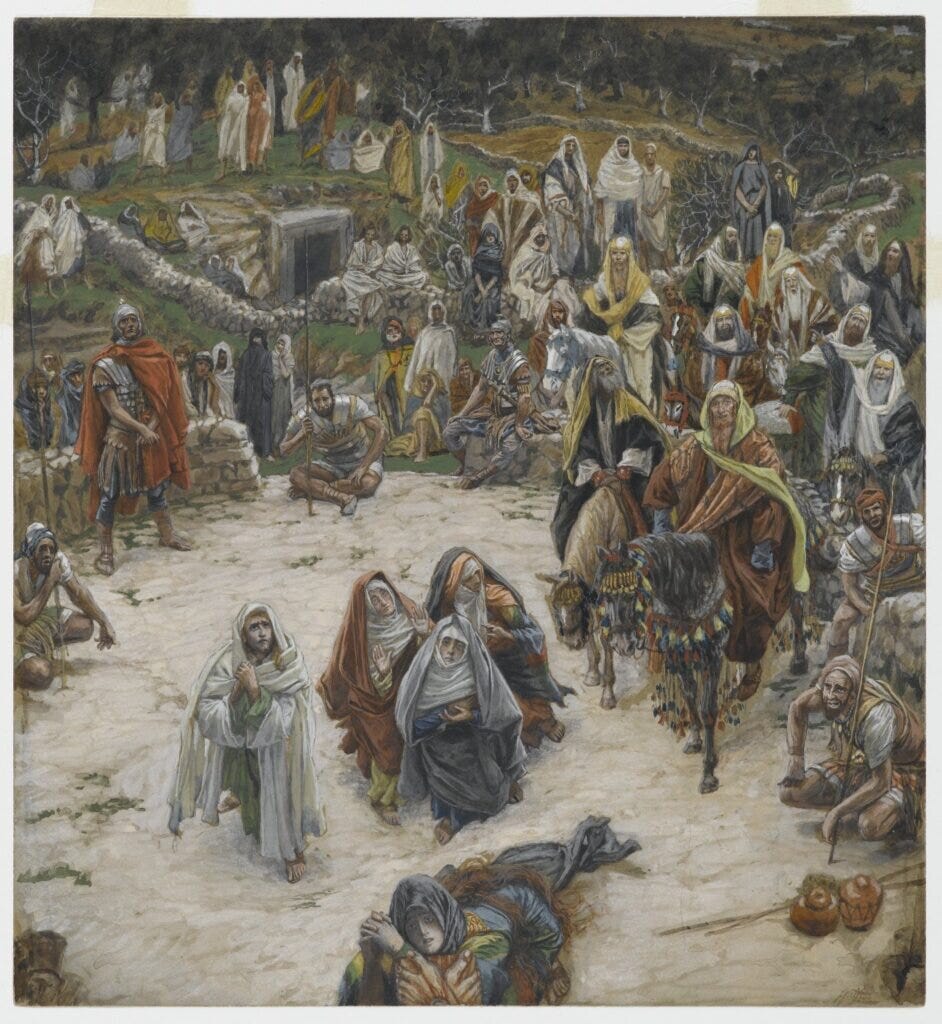




I have been loving these Holy Week themed posts. Each day I’ve learned something new.
Visual and written meditations on Good Friday by the French artist James Tissot. Thank you for posting, Roseanne. It is what I needed today.